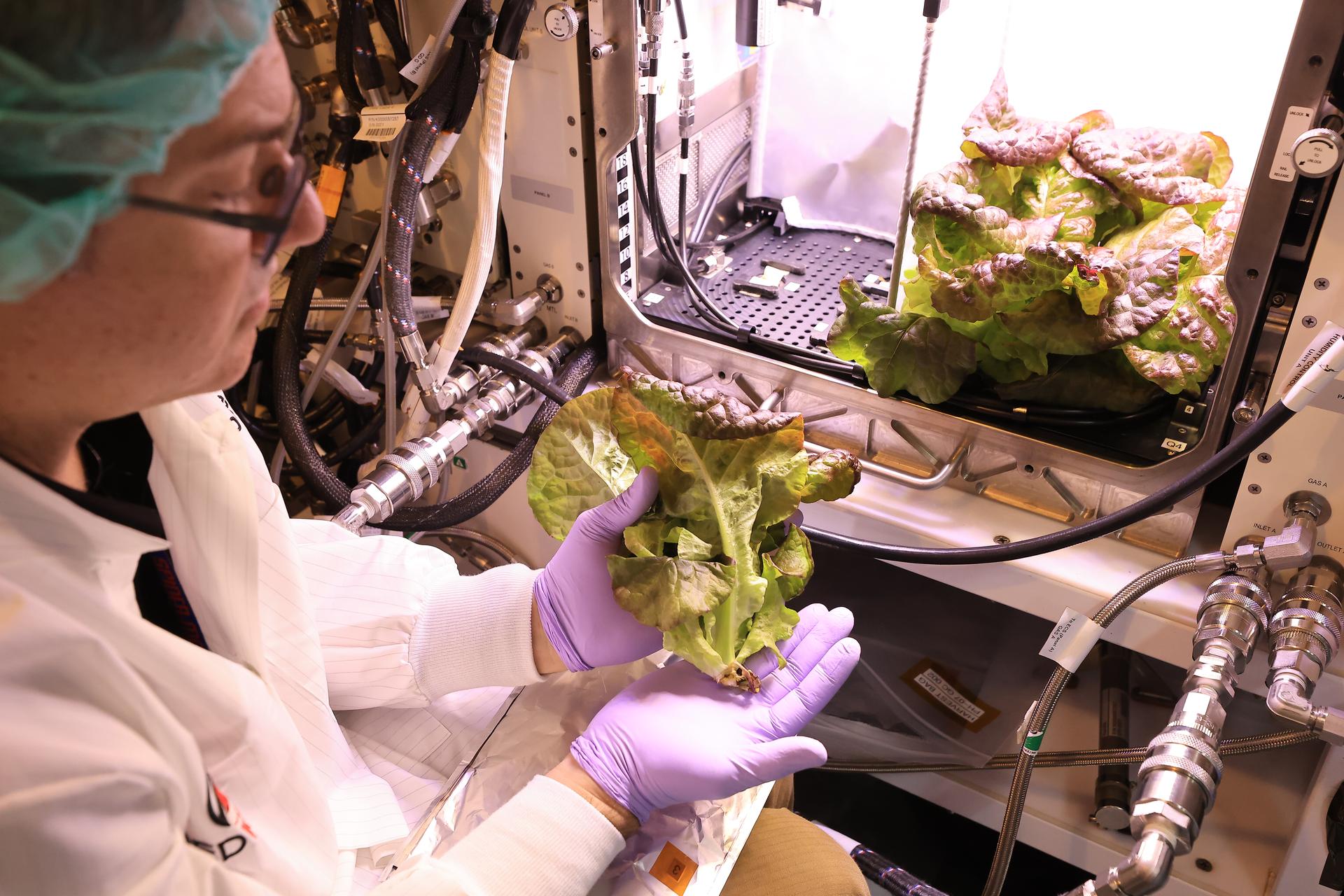NASA Harvests Lettuce for Space Station Study
- NASA has harvested lettuce from its Advanced Plant Habitat ground unit as part of an experiment to study plant growth in microgravity.
- The experiment aims to understand how optimal and suboptimal moisture conditions affect plant growth, nutrient content, and the plant microbiome in space.
- This research is part of NASA’s efforts to grow safe and nutritious food for astronauts on long-duration missions to the Moon, Mars, and beyond.
- The ‘Outredgeous’ romaine lettuce variety was first grown aboard the International Space Station in 2014 and has been used in previous experiments.
- Findings from this work could lead to agricultural advances here on Earth and support future space missions.
Inside a laboratory in the Space Systems Processing Facility at NASA’s Kennedy Space Center in Florida, a payload implementation team member harvests ‘Outredgeous’ romaine lettuce growing in the Advanced Plant Habitat ground unit on Thursday, April 24, 2025. The harvest is part of the ground control work supporting Plant Habitat-07, which launched to the International Space Station aboard NASA’s SpaceX 31st commercial resupply services mission.
The experiment focuses on studying how optimal and suboptimal moisture conditions affect plant growth, nutrient content, and the plant microbiome in microgravity. Research like this continues NASA’s efforts to grow food that is not only safe but also nutritious for astronauts living and working in the harsh environment of space.
The ‘Outredgeous’ romaine lettuce variety was first grown aboard the space station in 2014, and Plant Habitat-07 builds on that legacy, using the station’s Advanced Plant Habitat to expand understanding of how plants adapt to spaceflight conditions. Findings from this work will support future long-duration missions to the Moon, Mars, and beyond, and could also lead to agricultural advances here on Earth.
Image credit: NASA/Kim Shiflett
link
Q. What is the purpose of the experiment conducted by NASA?
A. The experiment focuses on studying how optimal and suboptimal moisture conditions affect plant growth, nutrient content, and the plant microbiome in microgravity.
Q. Why is growing food for astronauts important?
A. Growing food that is not only safe but also nutritious for astronauts living and working in space is crucial for their health and well-being.
Q. What variety of lettuce was used in this experiment?
A. The ‘Outredgeous’ romaine lettuce variety was first grown aboard the space station in 2014.
Q. How does this experiment relate to future long-duration missions?
A. Findings from this work will support future long-duration missions to the Moon, Mars, and beyond.
Q. What is the Advanced Plant Habitat used for in this experiment?
A. The Advanced Plant Habitat is a ground unit used to expand understanding of how plants adapt to spaceflight conditions.
Q. Who launched the SpaceX 31st commercial resupply services mission that carried the payload?
A. NASA’s SpaceX launched the 31st commercial resupply services mission that carried the payload.
Q. What is the significance of studying plant growth in microgravity?
A. Studying plant growth in microgravity can lead to agricultural advances here on Earth and improve our understanding of how plants adapt to spaceflight conditions.
Q. How does this experiment contribute to NASA’s efforts?
A. This experiment continues NASA’s efforts to grow food that is safe, nutritious, and suitable for astronauts living and working in space.
Q. What will be the outcome of this research?
A. The findings from this work will support future long-duration missions to the Moon, Mars, and beyond, and could also lead to agricultural advances here on Earth.
Q. When was the ‘Outredgeous’ romaine lettuce variety first grown aboard the space station?
A. The ‘Outredgeous’ romaine lettuce variety was first grown aboard the space station in 2014.

